The fifteenth webinar of a series "Grounding and lightning protection: issues and problems arising in the design"
(was hold on September 7, 2016 at 11:00 MSC)
Full-screen mode with the quality of "720p" is recommended
Though it might be strange but catenary wire lightning rod is the most widely used type of a rod, and its efficiency is wells studied, because millions of kilometers of overhead power transmission lines are protected by catenary wire lightning rods - single or double. For many years, the International Committee of CIGRE has been collecting the world experience of using catenary wire lightning rods. Their reliability depending on the height of hanging and protection angle is defined at the level of 0,999. It should be noted that the static calculation method of a breakthrough probability, on which protection zones of lightning rods were defined in the regulatory documents AD 34.21.122-87 and IS-153-34.21.122-2003, they were mainly calibrated by the experience of using ground wires.
An important moment is the significantly great efficiency of catenary wire lightning rods in comparison to rod lightning rods of the same height. If to compare protection reliability of rod lightning rods and ground wires with an equal number of supports, on which lightning rods are installed, then the difference in the number of expected lightning breakthroughs to the protected objects will turn out to be within the order of magnitude.
All other things being equal, the greater protection reliability is provided by the organization of closed catenary wire lightning rods and disposition of ground wires with negative protection angles. It allows to minimize the height of ground wires hanging and reduce the number of strikes into the protected territory, and consequently the number of dangerous electromagnetic impacts on circuits of micro-electronics, including underground.
Another crucial advantage of catenary wire lightning protection is possibility of installing supports of ground wires outside the protected territory without any significant financial expenditure. This way it is possible to weaken the conductive connection between the ground electrodes of these supports and grounding contour of the protected object, which almost completely liquidates the penetration of lightning current into underground utilities. Finally, thanks to the removing supports of ground wires from the protected territory it allows to stop the formation of sliding spark channels of lightning current from the entry point into the ground, or orient them in a direction safe for the object.
Result - replacement of rod lightning rods by catenary wire in practically significant situations allows to solve the problem of electromagnetic compatibility.
Webinar text. Page 1
Estimated reading time: 60 minutes
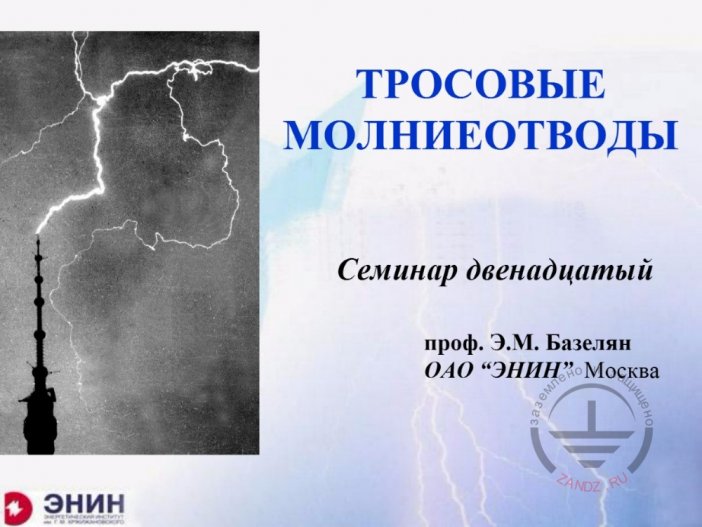
Lightning rods
- I am happy to congratulate you with the first of September, even though it is 7th but for us it is still the first. When I've been preparing myself for the seminar, I caught myself on a thought. You know that we elderly people become pigeons with years and when I am asked about my profession, I am happily answering that I am a lightning protection specialist and that I deal with ultra-high voltages and this causes respect to my personality, I am pleased. What I caught myself on is that today we don't have to talk much about ultra-high voltages, because the questions which are connected with lightning protection by the level of voltage go down and down and now when we deal with lightning protection, we start to talk about units of volts, because the main misfortune which lightning carries now is electromagnetic pickup in circuits controlling automation, relay protection in the channels of information transmission. It is the most important question today. Talking about catenary wire lightning rods, I will look back at the famous problem of electromagnetic compatibility, because it is the most important today for lightning protection specialists.
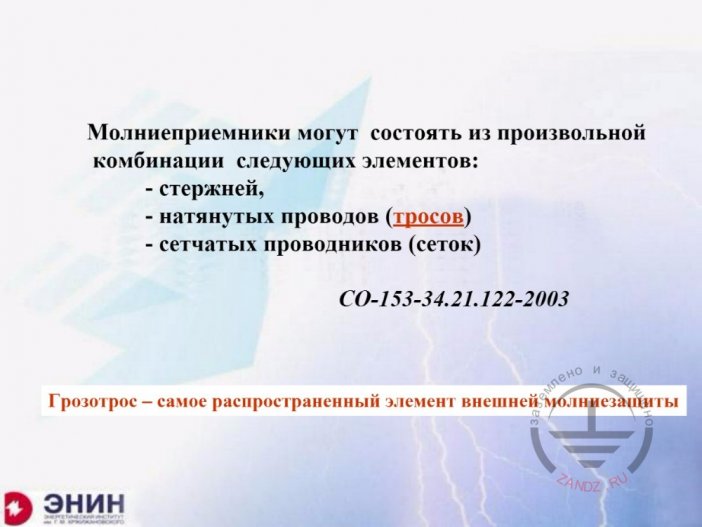
Composition of lightning rods
Lightning rods may consist of arbitrary combination of the following elements:
- rods
- wires (catenary wires)
- mesh conductors (meshes)
IS-153-34.21.122-2003
Ground wire is the most widely-used element of external lightning protection
- So if to talk about catenary wire lightning rods, we need to address to the regulatory document IS-153, where it is written that lightning rods can be rod, consist of strained wires and meshes. Designers acknowledge rods, but do not acknowledge meshes. Though the efficiency of these meshes is exclusively small. And the situation with wires is a bit strained.
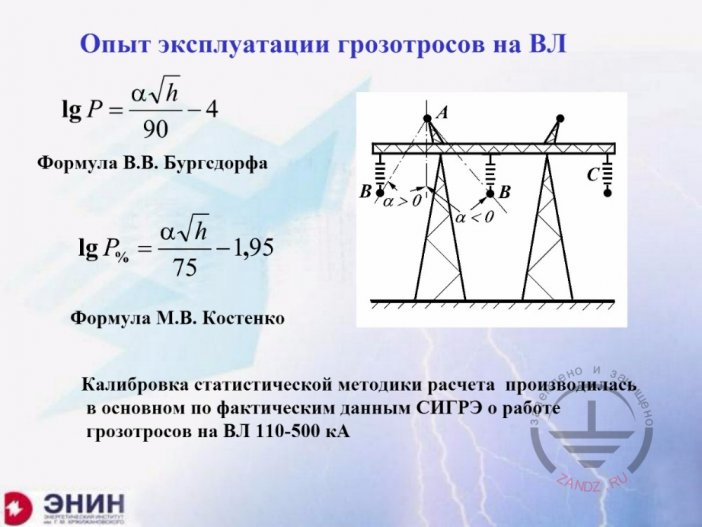
Experience of using ground wires on overhead power lines
V.V. Burgsdorf formula
M.V. Kostenko formula
Calibration of the static calculation method was held mainly according to CIGRE data about operation of ground wires on overhead power lines 110-500 kA
- For some reason, designers do not like catenary wire lightning rods, though they are the most widely used lightning rods in the world, because millions of kilometers of overhead power lines are protected by catenary wire lightning rods. And if to talk about what we know about lightning rods, we know how catenary wire lightning rods act, how they protect overhead power lines and all the information we have is pulled up from catenary wire lightning rods. In the middle of the recent century, two our large specialists on lightning protection Vladimir Vladimirovich Burgsdorf and Mikhail Vladimirovich Kostenko united information which CIGRE collected - it is international commission on electric circuits and this commission processed the data which give the possibility to calculate the probability of lightning breakthrough through catenary wire lightning protection. So the calculation formulas which were offered by our specialists Burgsdorf and Kostenko, they still exist and they are in two different forms. In one case the logarithm of lightning breakthrough probability is given in an ordinary value, in another - in percent, these formulas are different only in that.
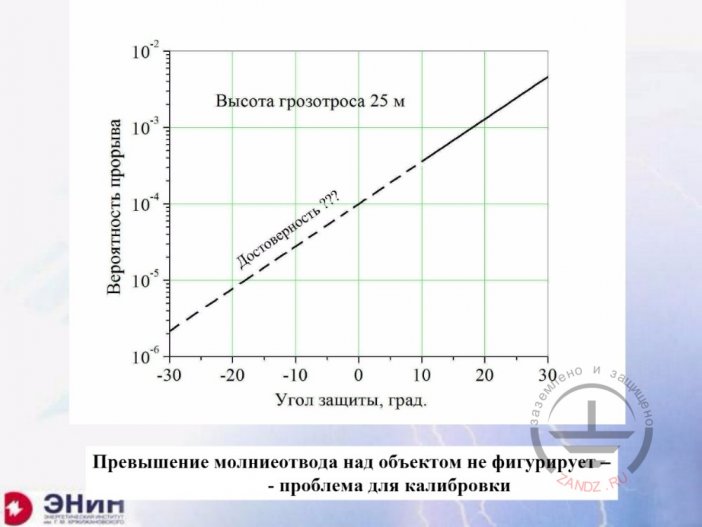
Probability of a lightning breakthrough
Вероятность прорыва – breakthrough probability
Высота грозотроса 25 м – ground wire height 25 m
Достоверность- authenticity
Угол защиты, град – protection angle, degrees
Превышение молниеотвода над объектом не фигурирует – проблема для калибровки- elevation of the lighting rod above the object does not feature -problem for calibration
- So if to summarize these two formulas, the following thing happens. It turns out that depending on the protection angle the probability of a lightning breakthrough increases strongly, and the reliability of protection becomes worse, if to reduce the angle and switch to negative protection angles, then the reliability of protection becomes exclusively high. If to take this theoretic curve, then look, only a small piece of the curve is given in a full line. This part, which is in full lines, says that there are quite a lot of experimental points and we can count on the fact, that the data given by the calculation formulas they are really justified by a great use experience. This fill curve comes to the level 10-3 that is one lightning out of a thousand breaks through to the protected object. These are ultimate values, which can be used for testing any calculation methods, if to speak frankly, these are the zones of rod lightning rods which you like a lot and which are given in the regulatory documents AD- 34 and IS -153. These zones are received by the calibration of the data given by the catenary wire lightning rods. If there were no catenary wire lightning rods, there would not be protection zones of rod lightning rods. That's the situation.
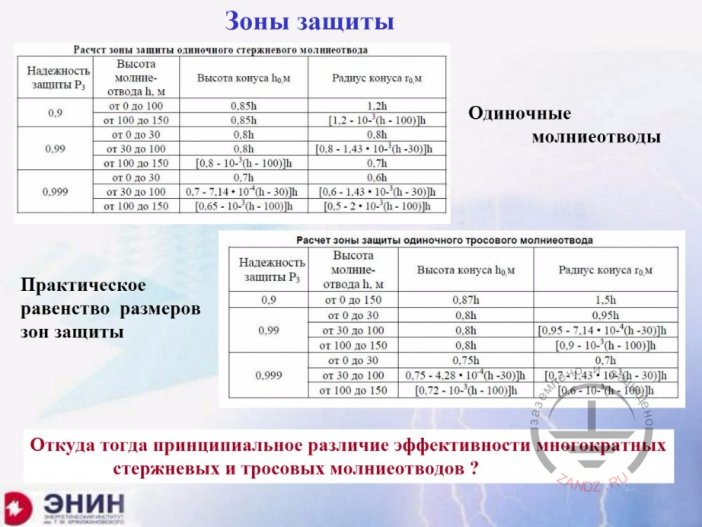
Protection zones
Расчет зоны защиты одиночного стержневого молниеотвода – calculation of protection zone of a single rod lightning rod
Надежность защиты – protection reliability
Высота молниеотвода – lightning rod height
Высота конуса – cone height
Радиус конуса – cone radius
Одиночные молниеотводы- single lightning rods
Откуда тогда принципиальное различие эффективности многократных стрежневых и тросовых молниеотводов? – where does this crucial difference of efficiency of multiple rod and catenary wire lightning rods come from?
- If you look at the protection zones of rod lightning rods. I downloaded this chart from IS-153. And protection zones of catenary wire lightning rods, you will see that the sizes of these zones are practically the same. If they differ for catenary wire and rod lightning rods, they differ within 10 or 15 %. And now I will tell you some seditious words, that the reliability of catenary wire lightning rods turns out to be disproportionally higher the ordinary rod lightning rods. Comparing with those two charts, which are downloaded from the guidelines - maybe it looks wild, but still it is a dry fact.
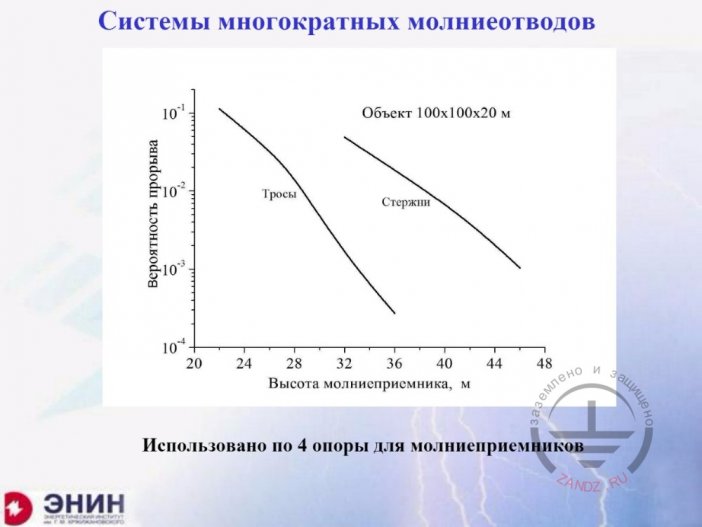
Systems of multiple lightning rods
Вероятность прорыва – breakthrough probability
Тросы - wires
Стрежни - rods
Объект - object
Высота молниеприемника, м- lightning rod height, m
Использовано по 4 опоры для молниеприемников – 4 supports for lightning rods are used
- And now to demonstrate this dry fact, I want to show you such a thing. I have an object. Let's suppose the object is a workshop or a large warehouse of a size 100*100 meters and 20 meters high. I want to apply rod lightning rods for the protection of this warehouse and I want to offer catenary wire lightning rods. I take 4 supports, put these 4 supports at the corners of the warehouse and put rod lightning rods on them. I have a curve, which shows how the probability of a lightning breakthrough changes depending on the height of rod lightning rods. I will orient on the probability of a breakthrough of 0,01, that is protection reliability of 0,99 and see what rods I need. It turns out so that I need rod lightning rods 40 meters high. But if I take the same supports and run a wire on the perimeter of the warehouse, then I will get protection reliability of 0,01 at the height of wire hanging of 28 meters. Imagine the difference of 12 meters is not only in money, which will be spent on the cost of supports.
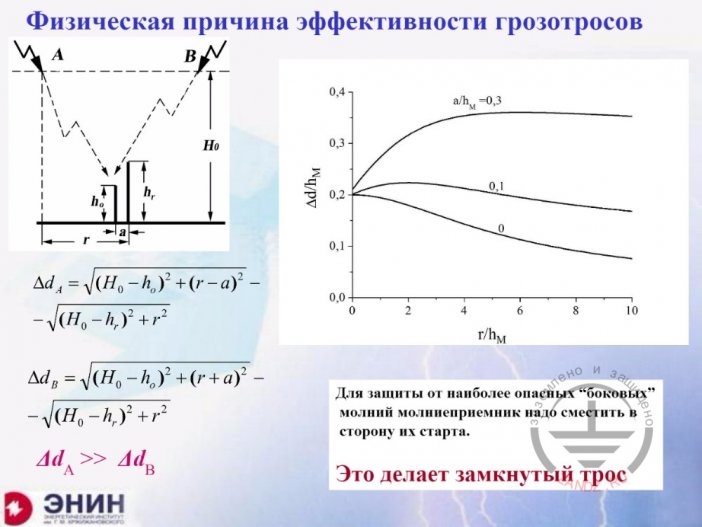
Physical reason of ground wires efficiency
Для защиты от наиболее опасных боковых молний молниеприемник надо сместить в сторону их старта – for the protection of most dangerous side lightning, the lightning rod should be moved to the side of their start
Это делает замкнутый трос – the closed wire will make it
- Because of what? It is important to understand this advantage is because of what. Look at these primitive pictures. Rod lightning rod, and some object is standing near. I showed this picture at some seminar. Look, God is sending lightning from different sides to us. We will look at the lightning from point A and from point B. The probability of a breakthrough to the protected object is different. The channel from point A initially goes to the object. From point B it initially goes to the lightning rod. The difference in these distances defines the protection reliability. Rod lightning rod protects objects from one side only - from the back area. If to talk about lightning going from the opposite side, then the protection is much weaker here and it is confirmed by the difference of one and another distance. And what will happen if I move to the side from the object or to the lightning rod? It turns out so, that if I move from the object horizontally to the side, the difference of these distances reduces and the protection reliability starts to fall down. And if I move to the side from the lightning rod, the difference of these distances will increase and the reliability of protection will increase. The wires are good because whatever side lightning comes from, the wire will be on its way first. And thanks to such a catenary wire lightning protection which surrounds the protected territory, the protection reliability increases strongly.
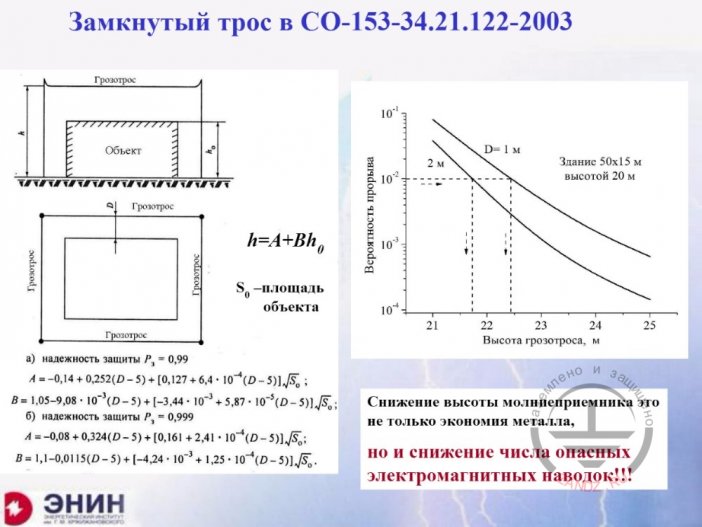
Closed wire in IS 153-34.21.122-2003
Вероятность прорыва – breakthrough probability
Здание - building
Высотой 20 м – 20 m high
Высота грозотроса. М – ground wire height, m
Снижение высота молниеприемника это не только экономия металла, но и снижение опасных электромагнитных наводок – reduction of lightning rod height is not only economy of metal, but reduction of dangerous electromagnetic pickup
Надежность защиты- protection reliability
Площадь объекта – object square
- This moment is reflected in the regulatory document. In IS-153-34.21.122 there is a section which not many people read - it's a section for calculating closed catenary wire lightning rod. Look what we are talking about. You have an object, it is a front view. There are supports on the top and a catenary wire lightning rod is hanging on these supports around the perimeter. So whatever side lightning comes from: left, right, from here, from there, it initially faces this catenary wire lightning rod. And in the result of this, the protection reliability improves strongly. For example, if I place catenary wire lightning rods with the rise of 2 meters, then the reliability of 0,99, when only one lightning out of 100 is breaking through, is provided for the object 20 meters high only in case when the height of a lightning rod is less than 2 meters above the roof of the protected object. Wires are very promising in this relation and they do not exceed the height of the building -it means they do not attract additional lightning. It means the protection reliability from electromagnetic pickup becomes more reliable. It is the first and the most important advantage of catenary wire lightning rods. Catenary wire lightning rods with a high protection reliability can get along with a small elevation above the protected object and it is a very good and favorable quality which you designers almost do not use.
Next Page >>
Slides 9 to 16
Related Articles:
 Lightning Protection of Large Territories: Parks, Grounds, Plant Territories. Page 1
Lightning Protection of Large Territories: Parks, Grounds, Plant Territories. Page 1
 Lightning Protection of Large Territories: Parks, Grounds, Plant Territories. Page 2
Lightning Protection of Large Territories: Parks, Grounds, Plant Territories. Page 2
 Lightning Protection of Large Territories: Parks, Grounds, Plant Territories. Page 3
Lightning Protection of Large Territories: Parks, Grounds, Plant Territories. Page 3

